Originally written as a standard that would split the points equally between type and coat elements, CFA’s standard does place more emphasis on the coat than any other association.

Originally written as a standard that would split the points equally between type and coat elements, CFA’s standard does place more emphasis on the coat than any other association. The challenge in evaluating is to ensure that CFA Bengals do not deviate from acceptable Bengal type yet have the highest quality coats and most correct patterns.
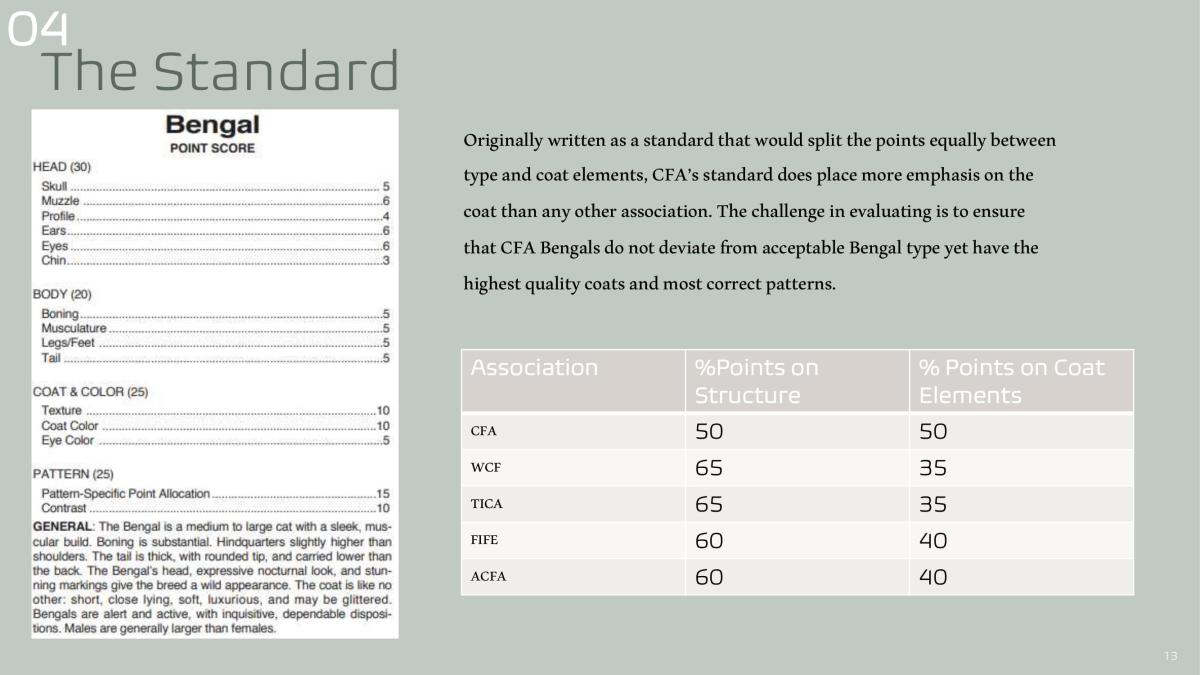
HEAD
Broad modified wedge with rounded countours , longer than wide, with high cheekbones. Slightly small in proportion to body, not to be taken to extreme. Top of skull flows back into the neck, with visible back skull. Allowance for jowls on mature males.
• Note that eyes, muzzle , and ears have the same point allocation . These important features are crucial to a well balanced Bengal head.
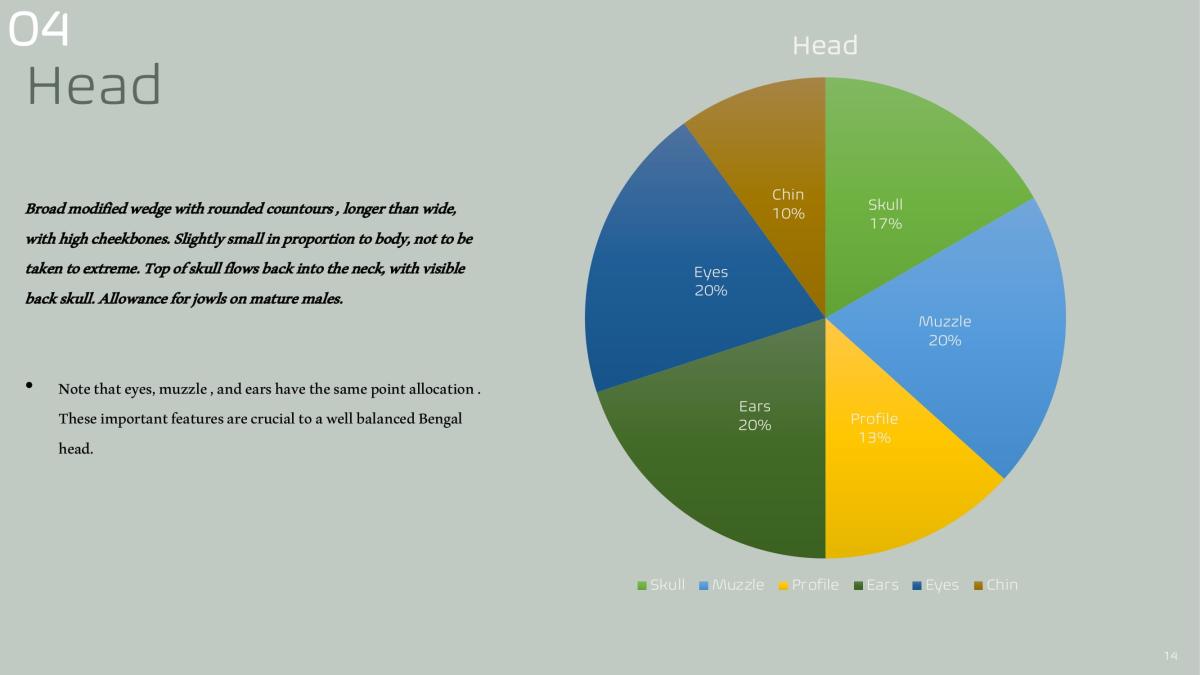
0S4kull / Head shape
• Broad modified wedge – more contoured and rounded than the wedge of more foreign breeds like a Siamese.
• Longer than wide – The length should be in the top 2/3, the back skull and the forehead of the cat.
• Somewhat small in proportion to the body.
• Allowance for jowls on mature males.
• Visible back skull, top of head should be rounded, not completely flat. Some angles of photographs or very muscular necks can obscure the back skull, it’s important to feel the structure.
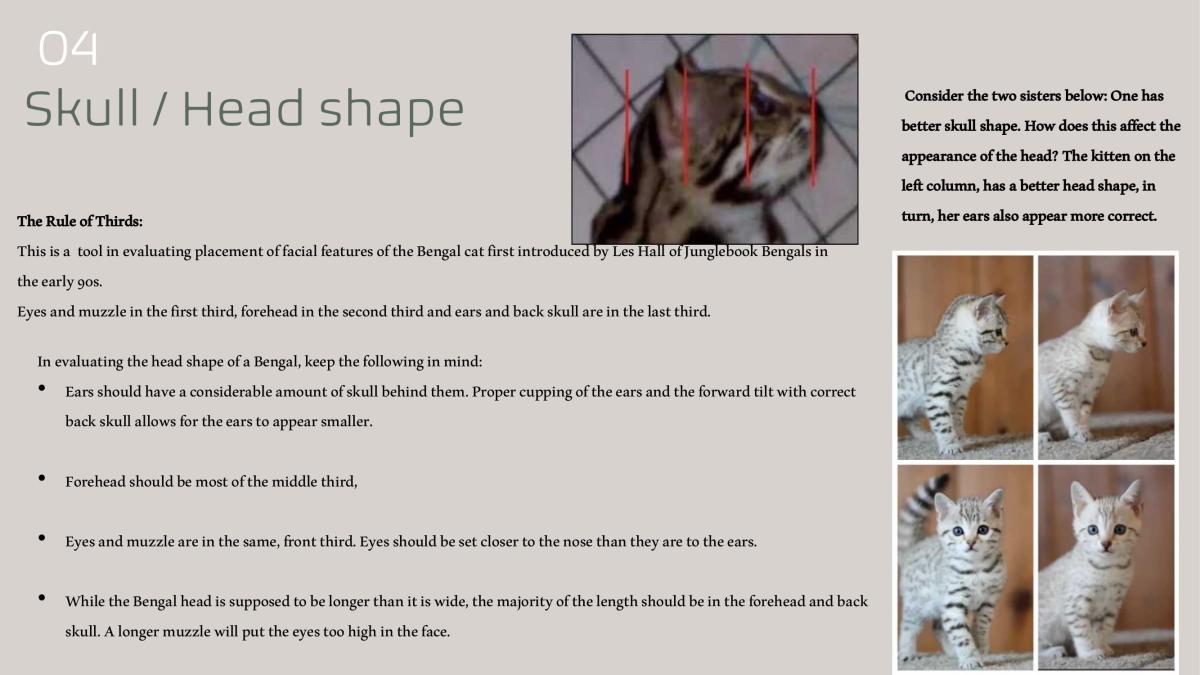
Skull / Head shape
The Rule of Thirds:
This is a tool in evaluating placement of facial features of the Bengal cat first introduced by Les Hall of Junglebook Bengals in the early 90s.
Eyes and muzzle in the first third, forehead in the second third and ears and back skull are in the last third.
In evaluating the head shape of a Bengal, keep the following in mind:
• Ears should have a considerable amount of skull behind them. Proper cupping of the ears and the forward tilt with correct back skull allows for the ears to appear smaller.
• Forehead should be most of the middle third,
• Eyes and muzzle are in the same, front third. Eyes should be set closer to the nose than they are to the ears.
• While the Bengal head is supposed to be longer than it is wide, the majority of the length should be in the forehead and back skull. A longer muzzle will put the eyes too high in the face.
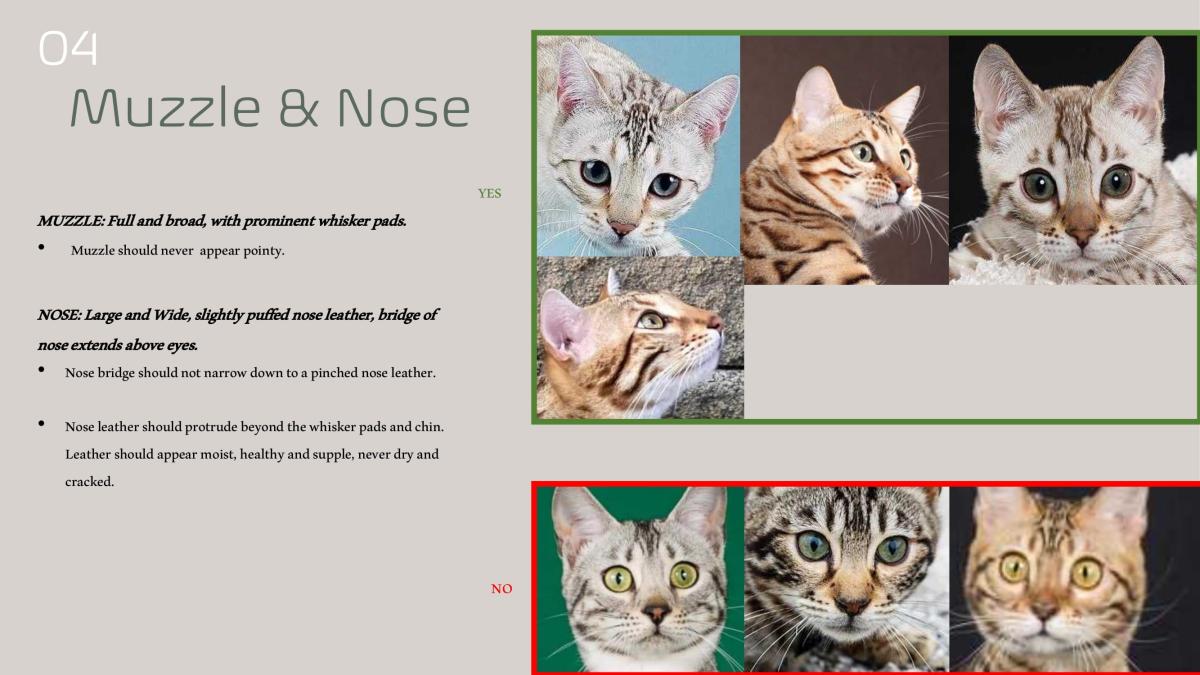
Muzzle & Nose
MUZZLE: Full and broad, with prominent whisker pads.
• Muzzle should never appear pointy.
NOSE: Large and Wide, slightly puffed nose leather, bridge of nose extends above eyes.
• Nose bridge should not narrow down to a pinched nose leather.
• Nose leather should protrude beyond the whisker pads and chin. Leather should appear moist, healthy and supple, never dry and cracked.
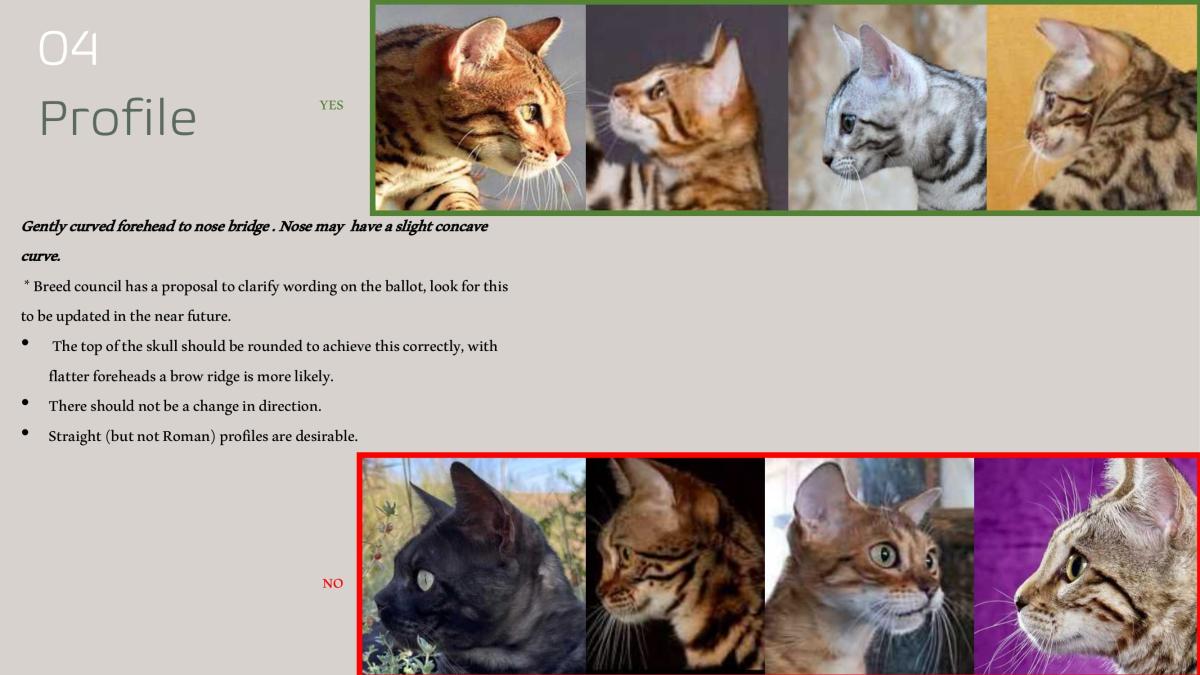
Profile
Gently curved forehead to nose bridge . Nose may have a slight concave curve.
* Breed council has a proposal to clarify wording on the ballot, look for this to be updated in the near future.
• The top of the skull should be rounded to achieve this correctly, with flatter foreheads a brow ridge is more likely.
• There should not be a change in direction.
• Straight (but not Roman) profiles are desirable
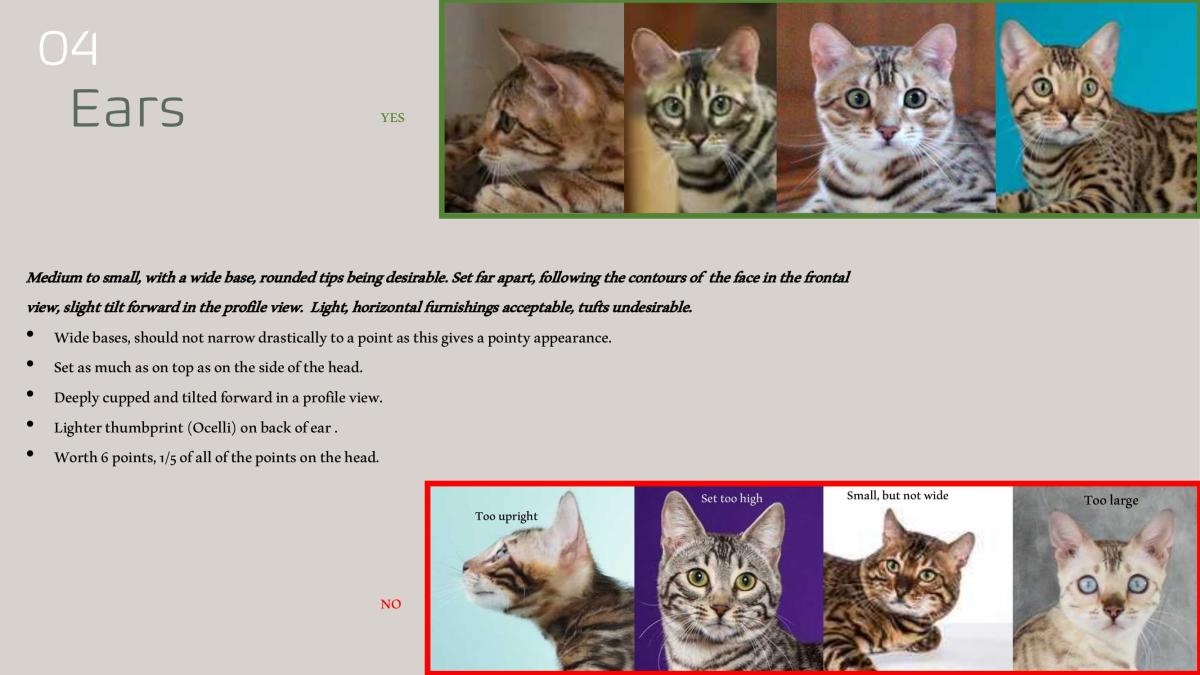
EARS
Medium to small, with a wide base, rounded tips being desirable. Set far apart, following the contours of the face in the frontal view, slight tilt forward in the profile view. Light, horizontal furnishings acceptable, tufts undesirable.
• Wide bases, should not narrow drastically to a point as this gives a pointy appearance.
• Set as much as on top as on the side of the head.
• Deeply cupped and tilted forward in a profile view.
• Lighter thumbprint (Ocelli) on back of ear .
• Worth 6 points, 1/5 of all of the points on the head.
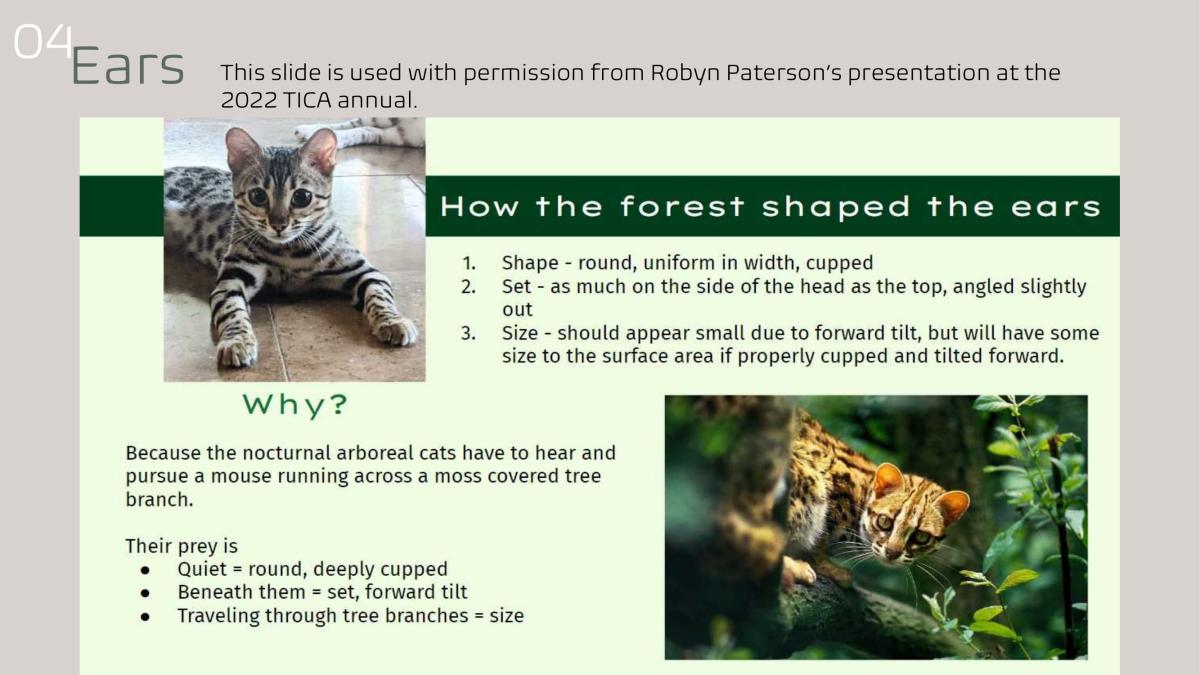
EYES
Shape is round to oval. Large, but not bugged, set wide apart, with a slight bias toward the base of ear, when oval in shape. Eye color independent of coat color except in Lynx Points, where Blue is the only acceptable color. Richness and depth of color is always preferred. * Breed council is debating changes currently, look for this to be updated in the near future.
• Nocturnal look – Size (large) and position are more important than the shape when the goal is to achieve a nocturnal expression. Eyes should be set in the lower third of the face.
• Large but not bugged: the cat should be alert or excited when evaluating in order to see the eye at its largest.
• Widely set- Slight bias toward the ear
• Richness and depth of color preferred.
• Worth 6 points, 1/5 of all the points on the head
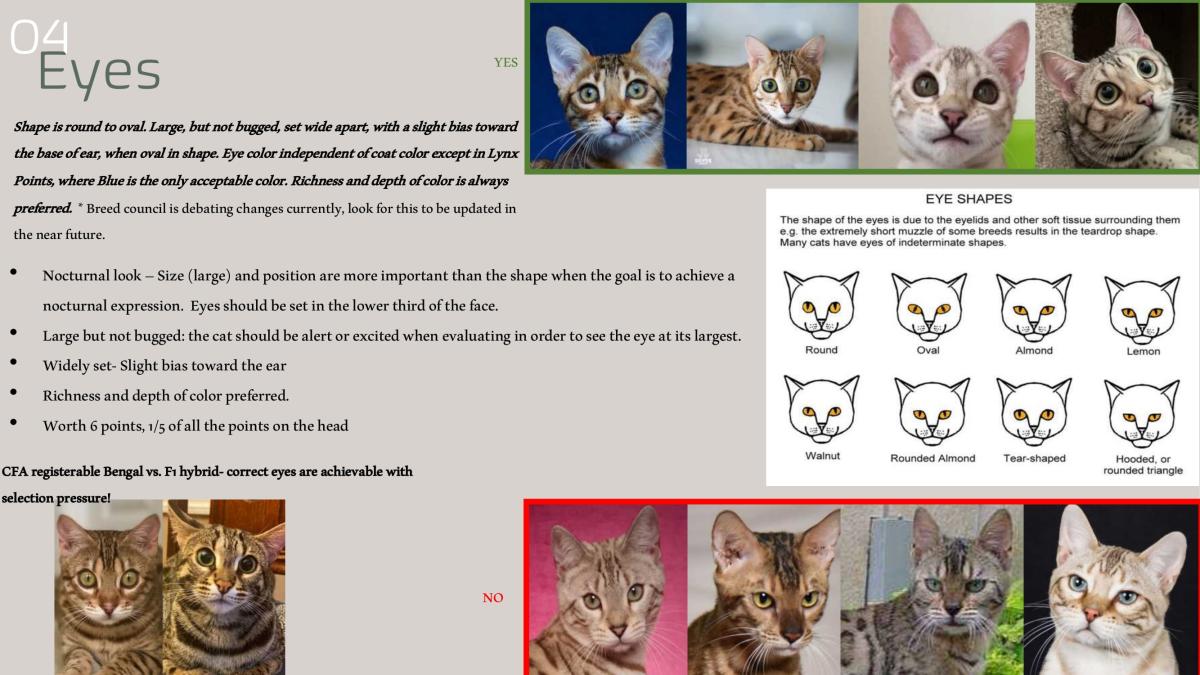
Eyes
This slide is used with permission from Robyn Paterson's presentation at the 2022 TICA annual.
How the forest shaped the eyes
The Leopard cat (top left) and the Margay (bottom left) live in forests on different continents, but their eyes are similar because they are fit for purpose.
Cats who hunt by the dappled moonlight in trees need eyes that are: Large
Set forward on the face Large surface area to the lens
Notice the different eye structure on the Pallas cat (top right) and Serval (bottom right). They hunt at dawn and dusk in the glare of the sun.
The eyes are deeply set to protect them from glare.
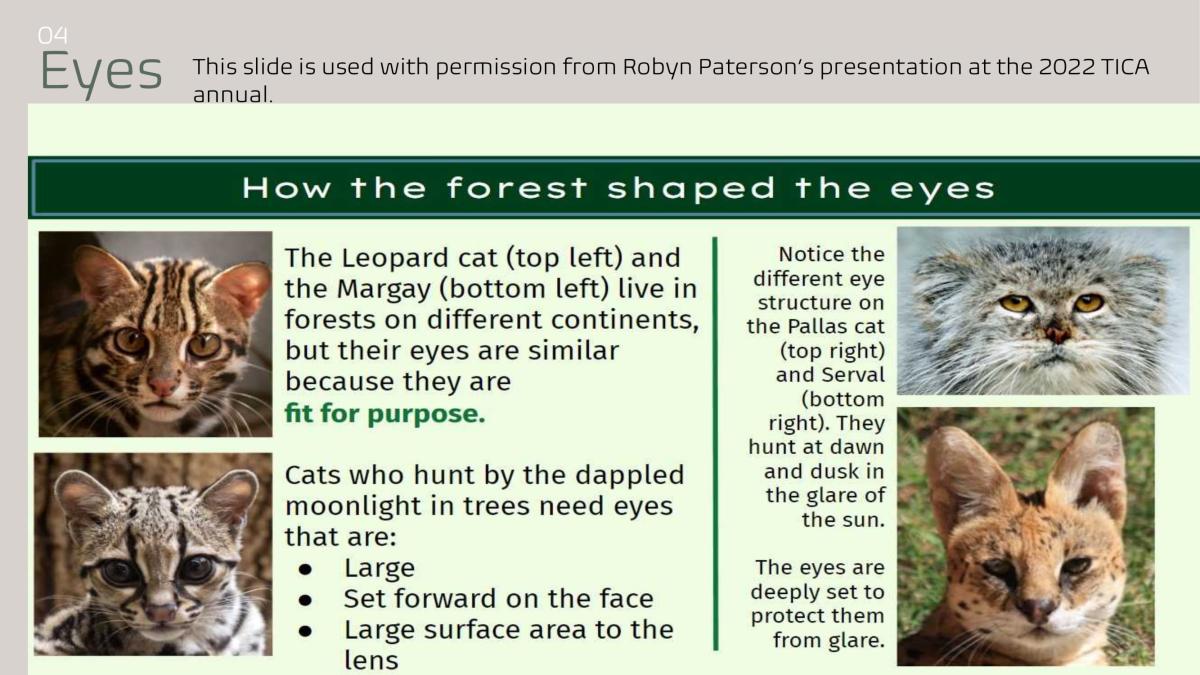
Eyes
This slide is used with permission from Robyn Paterson's presentation at the 2022 TICA annual.
How the forest shaped the eyes
Why?
1. The eyes should be a dominating feature on the face.
2. To get the best look, play with the Bengals in their cages. The bright light on your judging table will be too bright for a nocturnal eye.
3. Assess the surface area of the lens from profile view.
Because the nocturnal arboreal cats hunt in dappled moonlight, their eyes are structured to let as much light in as possible. Their eyes must let light in which influences every aspect of their formation.
- Size
- Set
- Surface area of the lens
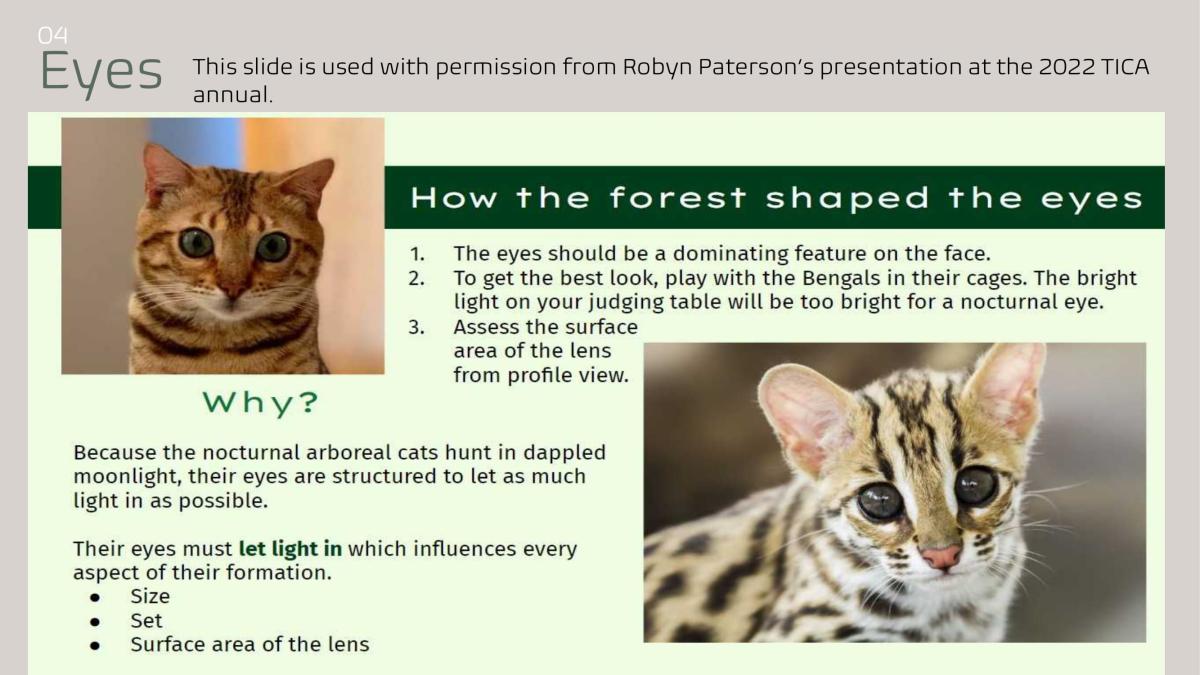
CHIN
Strong, substantial, aligns with the tip of the nose in profile.
• Worth 3 points, the least of any one feature of the head.
• Keep in mind that the jaw structure and the muscles attaching to the chin also affect the visible depth of the chin, for this reason it’s best to evaluate the chin at a relaxed position vs. manipulating any part of the head or neck.
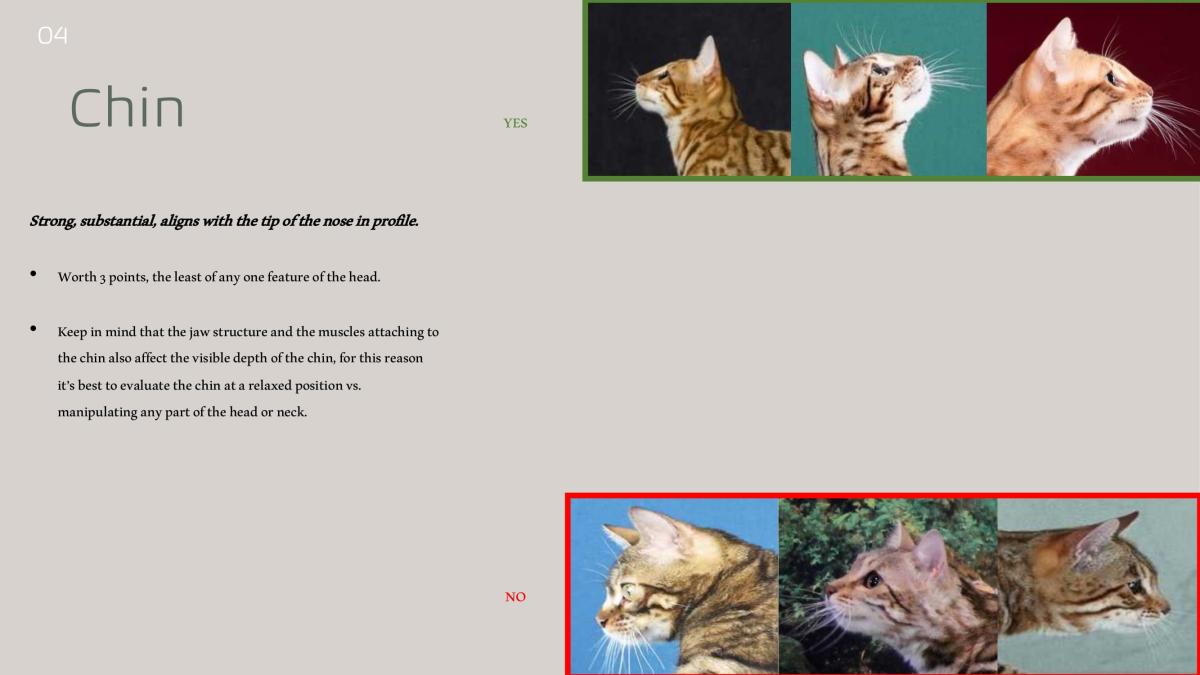
Chin
This slide is used with permission from Robyn Paterson's presentation at the 2022 TICA annual.
How the forest shaped the chin
The chin is the bottom attachment point of the jaw muscles. Bengal chin muscles are sometimes visible when the chin muscles are relaxed and drop forward.
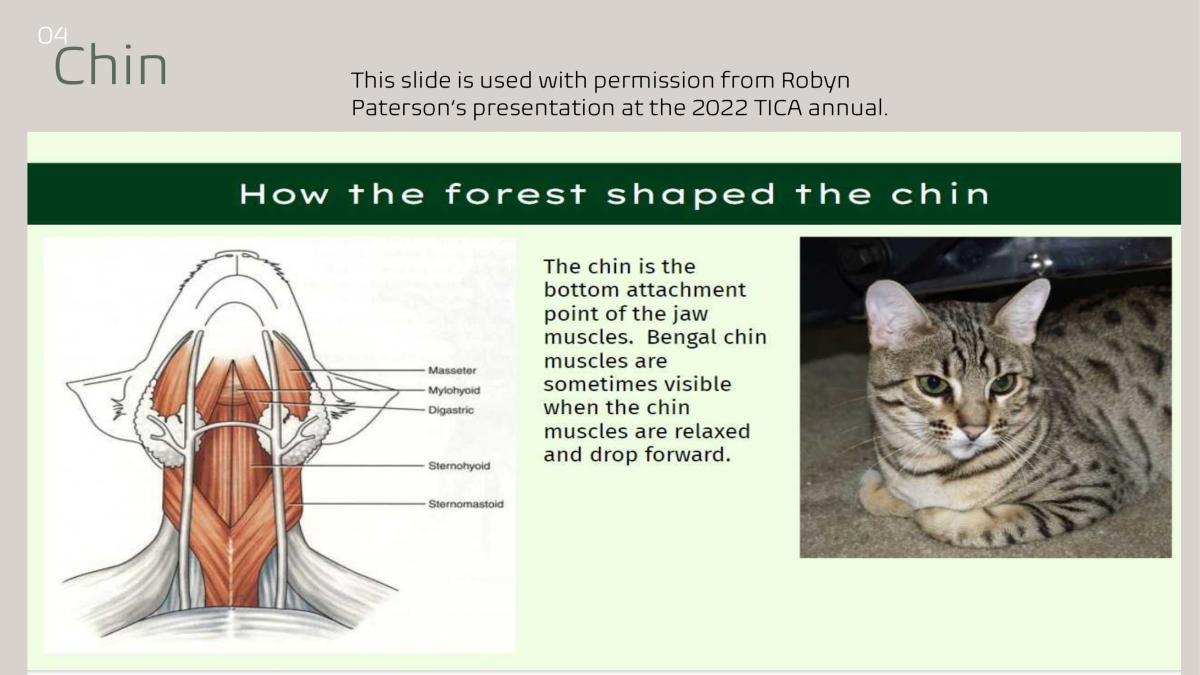
Body
Long and substantial, muscular, particularly the males. Hindquarters slightly higher than shoulders.
• Correct body shape of a Bengal reflects the shape of a small forest dwelling jungle cat.
• Long and lithe, yet athletic and well muscled.
• Torso shape should be lean and no tendency toward barrel chest. No belly tuck in adult cats.
• Weight should be centered on the muscular rear legs, body should deepen towards the rear as a result of the primordial pouch and musculature.
• Longer rear legs.
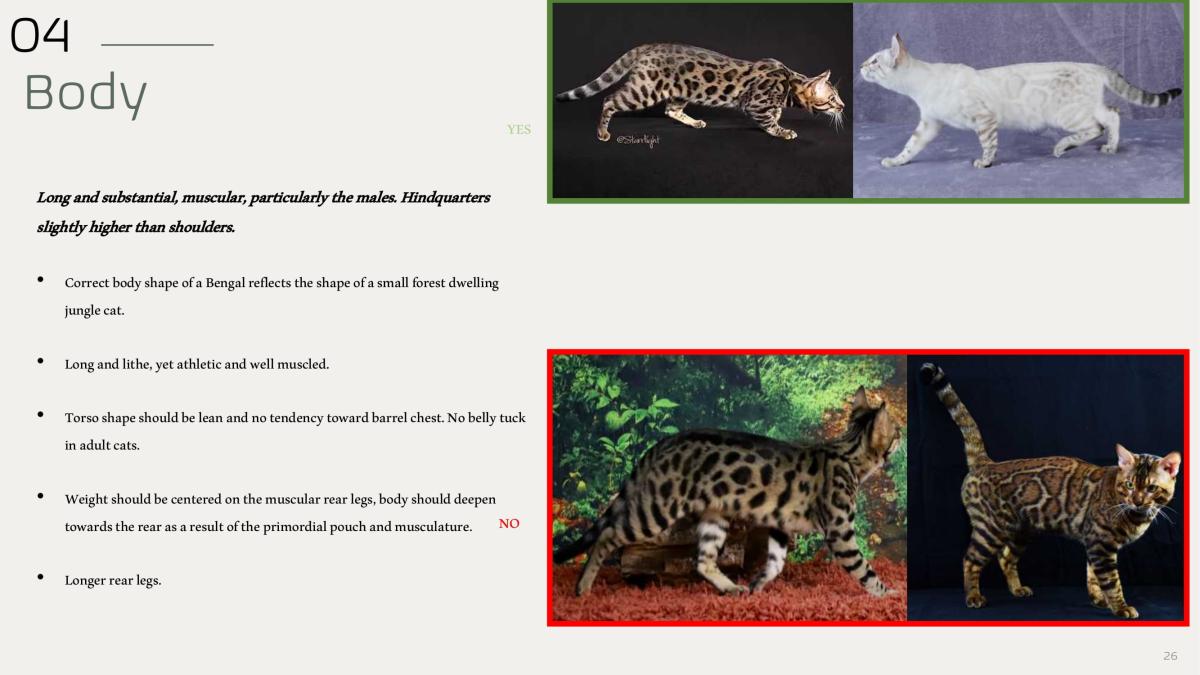
Body
How the forest shaped the body
Primordial Pouch
Primordial pouches are not required. There is no preference for or against them. Please don't discredit a cat with pouches.
The unique trees of Asian forests have shaped the Bengal cat because trees in Asian forests are tall and widely spaced.
Many animals, including the small wildcats, that live in canopy of the Asian forests evolved a larger flap of skin that stretches out further allowing for longer jumps from tree branch to a tree branch as it creates a slight gliding ability.
While all cats have a primordial pouch, the Leopard cat has morphed this into a larger feature that gives the Asian forest dwellers the ability to stay in the air a little bit longer to make those long jumps from tree to tree.
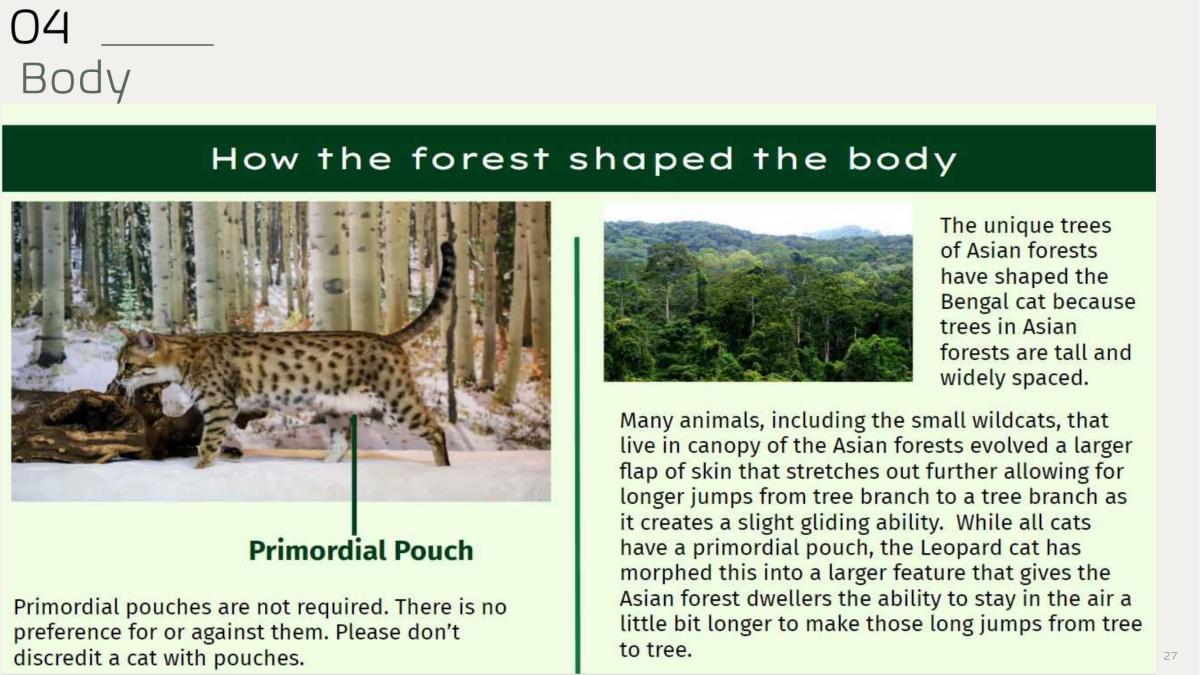
Body
Bone: Substantial, never delicate.
The heavier bone structure is especially evident in the legs, they should give an impression of a sturdy, well built cat.
Legs: Medium long, slightly longer rear legs.
Muscular.
A Bengal's legs are built for running, leaping, climbing and other athletic endeavors.
Paws: Large and round, with prominent knuckles.
The feet of the Bengal are proportionally larger than many other breeds, likely due to larger boning.
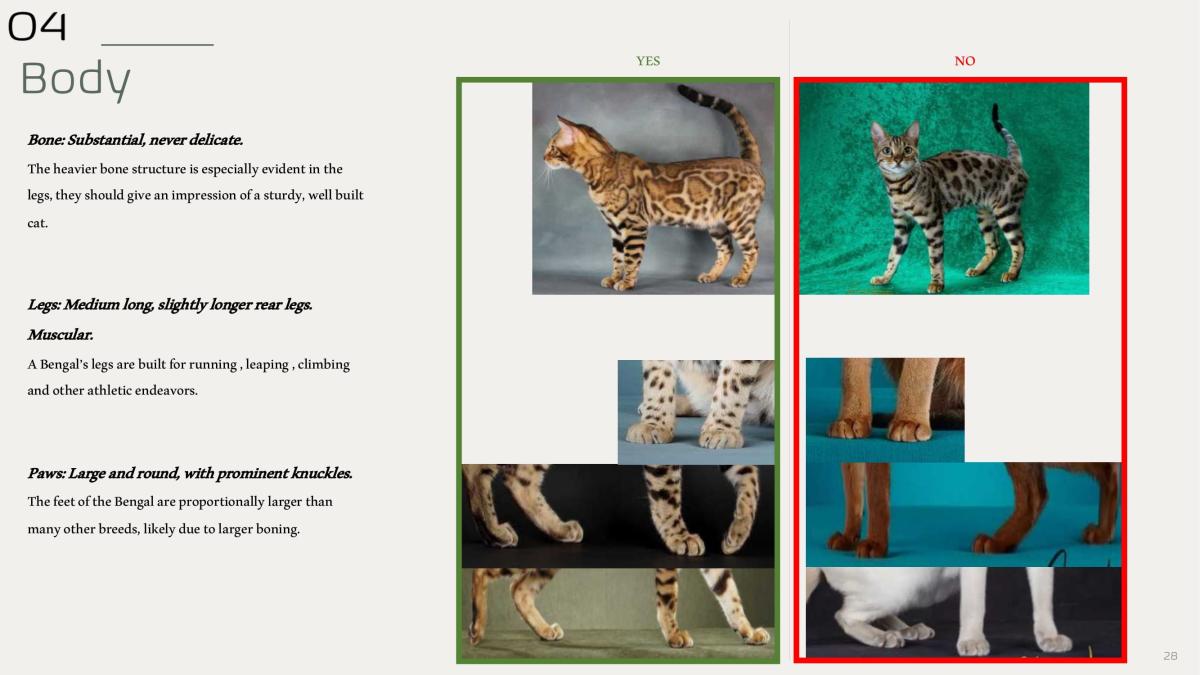
Body
Tail: Thick, tapered at the end with a rounded tip. Medium in length, in proportion to the body.
• Tail set – Tail should be carried low with an allowance for “happy tail” when the cat is confident and alert and carries the tail straight up.
• Rosetted and spotted tails should be given extra merit.
• “Squirrel Tail” where the cat carries the tail over the back is not correct.
• Whippy, thin tails are not desirable and more prone to injury in an active cat.
• There is a wide variation of normal boning / musculature of tails in this breed, palpable differences should not be penalized unless it is an obvious deformity or change in direction.
• Handling should be limited to 2-3 passes down the length of the tail.
• Visible faults should always be disqualified.
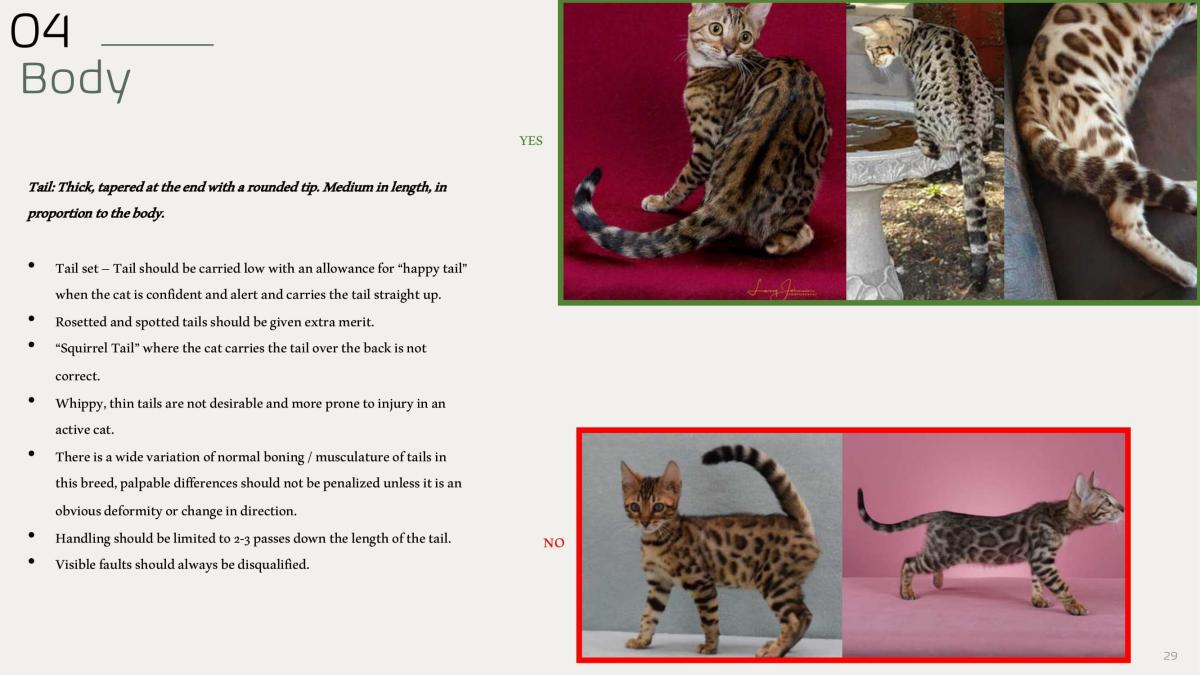
Acknowledgements and Full Credits to: https://cfa-files.s3.us-east-2.amazonaws.com/breed-presentations/Bengal.pdf
